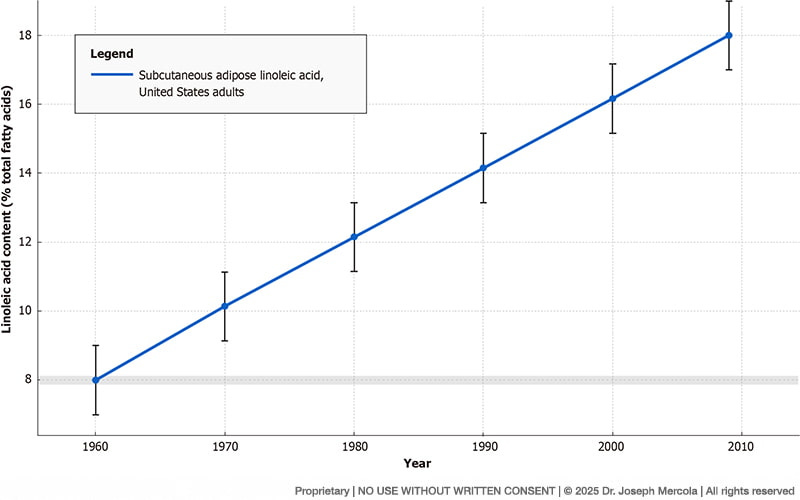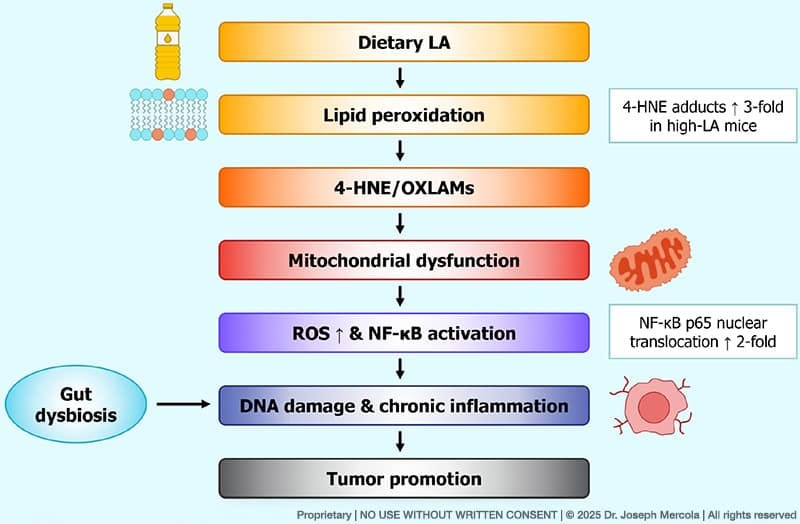Historical Rise of Cancer and Dietary Linoleic Acid — Mechanisms and Therapeutic Strategies
Description
STORY AT-A-GLANCE
Cancer now affects 30% to 50% of Americans, a massive increase from just 5% in 1900, reflecting how modern diets and lifestyles have reshaped your body’s internal terrain
Excess linoleic acid (LA) from seed oils triggers toxic byproducts, chronic inflammation, and mitochondrial breakdown, all of which weaken your body’s defenses and fuel tumor growth
Lowering LA intake from 7% to around 2% to 3% of daily calories has been shown to cut oxidative stress markers by 20% in as little as 12 weeks, giving your body a chance to recover
A four-phase terrain restoration strategy uses seed oil elimination, staged carbohydrate reintroduction, gradual fiber restoration, and metabolic supports like intermittent fasting and exercise to rebuild resilience
Simple daily steps — avoiding seed oils, rebuilding gut health, supporting mitochondria through movement and sleep, and tracking progress — give you control over your risk and long-term health

Cancer now strikes 30% to 50% of all Americans in their lifetime, compared to just 5% at the turn of the 20th century. This is not the result of better screening or recordkeeping — it reflects fundamental shifts in how your body’s terrain is shaped by modern living. What was once rare has become common, and the old explanations are no longer enough.
I recently published a landmark paper in the World Journal of Clinical Oncology, an internationally recognized, peer-reviewed journal known for advancing cutting-edge cancer research.1 In this work, I call for nothing less than a paradigm shift in how cancer is approached — moving away from patchwork symptom management and toward restoring health at the cellular level.
The framework I outlined challenges the current standard of care and instead focuses on correcting the metabolic imbalances, mitochondrial dysfunction, and inflammatory triggers that make your body more hospitable to disease. My paper lays the scientific foundation for practical, everyday strategies you can begin applying right now to reclaim your terrain.
By targeting root causes instead of chasing downstream effects, you put yourself in the best position to strengthen your defenses and lower your risk of cancer in a meaningful way. The next step is to unpack the key findings of this research and show you how restoring balance inside your cells changes the trajectory of your health.

Excess Linoleic Acid Creates a Cancer-Friendly Environment
My paper looked at how linoleic acid (LA), the main omega-6 fat in soybean, corn, and other seed oils, influences cancer development.2 I examined historical cancer trends and experimental findings to understand whether the dramatic increase in LA intake across the last century has helped drive higher rates of breast, prostate, colorectal, and melanoma cancers.
The rise in LA tracked closely with cancer incidence — As shown in the figure above, Americans once consumed just 1% to 2% of their daily calories from this fat, but today it accounts for 7% or more. During the same period, the lifetime risk of cancer climbed from 5% in 1900 to over 30% to 50% in modern times. This rise coincides with the widespread adoption of industrial seed oils in processed food, margarine, salad dressings, and frying oils.
Striking disease patterns tied to LA — High levels of LA in body tissues are repeatedly associated with greater risks of breast cancer (130 cases per 100,000 women), prostate cancer (112 cases per 100,000 men), colorectal cancer (39 cases per 100,000), and melanoma (26 cases per 100,000).3 These associations are supported by both biomarker studies — measuring LA stored in fat tissue — and dietary intake surveys.
Excess LA increases toxic byproducts inside your body — When this unstable fat breaks down, it forms damaging molecules like 4-hydroxynonenal (4-HNE) that attack your DNA, proteins, and mitochondria — the energy factories of your cells. These byproducts are like sparks in a dry forest, igniting chain reactions that overwhelm your body’s repair systems.
<label class="hide-text" contenteditable="false">Text within this block will maintain its original spacing when published</label>The figure above shows how too much LA from seed oils clogs your cell’s energy system. This overload builds up a waste product called succinate, which tricks your body into acting like it’s







